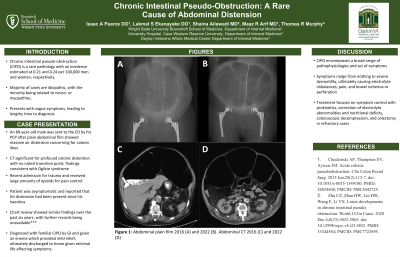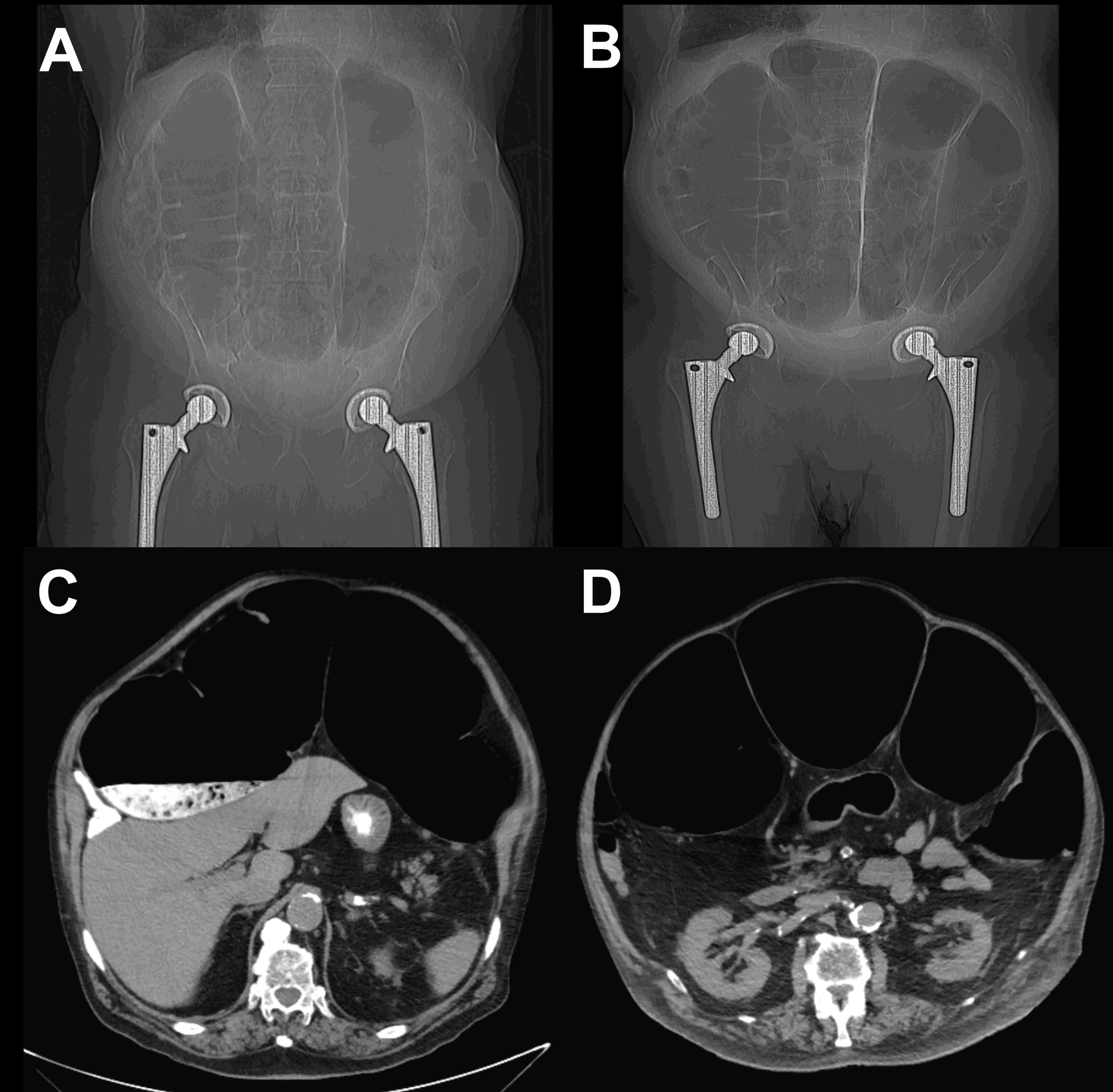Tuesday Poster Session
Category: Colon
P3097 - Chronic Intestinal Pseudo-Obstruction: A Rare Cause of Abdominal Distension
Tuesday, October 24, 2023
10:30 AM - 4:00 PM PT
Location: Exhibit Hall

Has Audio

Lakmal Ekanayake, DO
Wright State University
Dayton, OH
Presenting Author(s)
Lakmal Ekanayake, DO1, Issac Pearce, DO1, Shaina Ailawadi, MD2, Maaz Arif, MD1, Thomas Murphy, MD3
1Wright State University, Dayton, OH; 2University Hospitals, Cleveland, OH; 3Dayton VA, Dayton, OH
Introduction: Chronic intestinal pseudo-obstruction (CIPO) is a rare condition with an estimated incidence of 0.21 and 0.24 per 100,000 men and women, respectively. Despite its uncommon nature, this syndrome is one of the main causes of intestinal failure and is associated with high morbidity and mortality. Combined with its CIPO’s presentation with vague, non-specific symptoms such as abdominal pain and distension, it often leads to a lengthy time to diagnosis.
Case Description/Methods: An 89-year-old-male presented to the emergency department after his primary care physician ordered abdominal radiography showing massive air distention of the large bowel with concern for colonic ileus (Figure 1A, 1B). Abdominal computed tomography scan confirmed distension concerning for Ogilvie syndrome, with no clear transition point (Figure 1C, 1D). The patient denied acute symptoms and reported distention since his twenties, with a strong family history. Chart review revealed prior image findings consistent with intestinal pseudo-obstruction over the past six years, without documentation of further work-up. Recent history significant for a traumatic fall, for which opioids were prescribed. Bowel movements were normal with no reports of diarrhea, constipation, melena, or hematochezia. Upon gastroenterology consultation, enema was treatment of choice, which resulted in stool and a significant amount of gas produced. Unfortunately, the patient’s clinical condition did not improve. The diagnosis of familial CIPO was concluded, given exclusion of obstruction or impending colonic mass. Due to patient’s advanced age, minimal quality of life, therapy was deferred.
Discussion: Diagnosis of CIPO is one of exclusion1, often leading it to be a misdiagnosed pathological condition. Symptoms range from asymptomatic abdominal distension to severe dysmotility causing electrolyte imbalances, pain, and bowel ischemia or perforation1. CIPO can present as a challenging diagnosis for clinicians due to its low incidence among the population and non-specific presentation. Unfortunately, many patients develop nutritional deficits and 45% to 80% of CIPO patients ultimately require parenteral nutrition2. Medical treatments consist of prokinetics agents such as polyethylene glycol and neostigmine; surgical options include colonic decompression and colectomy. Through this case report, we encourage clinicians to have diagnostic suspicion of CIPO based on the combination of its clinical features, natural disease progression, and radiological signs

Disclosures:
Lakmal Ekanayake, DO1, Issac Pearce, DO1, Shaina Ailawadi, MD2, Maaz Arif, MD1, Thomas Murphy, MD3. P3097 - Chronic Intestinal Pseudo-Obstruction: A Rare Cause of Abdominal Distension, ACG 2023 Annual Scientific Meeting Abstracts. Vancouver, BC, Canada: American College of Gastroenterology.
1Wright State University, Dayton, OH; 2University Hospitals, Cleveland, OH; 3Dayton VA, Dayton, OH
Introduction: Chronic intestinal pseudo-obstruction (CIPO) is a rare condition with an estimated incidence of 0.21 and 0.24 per 100,000 men and women, respectively. Despite its uncommon nature, this syndrome is one of the main causes of intestinal failure and is associated with high morbidity and mortality. Combined with its CIPO’s presentation with vague, non-specific symptoms such as abdominal pain and distension, it often leads to a lengthy time to diagnosis.
Case Description/Methods: An 89-year-old-male presented to the emergency department after his primary care physician ordered abdominal radiography showing massive air distention of the large bowel with concern for colonic ileus (Figure 1A, 1B). Abdominal computed tomography scan confirmed distension concerning for Ogilvie syndrome, with no clear transition point (Figure 1C, 1D). The patient denied acute symptoms and reported distention since his twenties, with a strong family history. Chart review revealed prior image findings consistent with intestinal pseudo-obstruction over the past six years, without documentation of further work-up. Recent history significant for a traumatic fall, for which opioids were prescribed. Bowel movements were normal with no reports of diarrhea, constipation, melena, or hematochezia. Upon gastroenterology consultation, enema was treatment of choice, which resulted in stool and a significant amount of gas produced. Unfortunately, the patient’s clinical condition did not improve. The diagnosis of familial CIPO was concluded, given exclusion of obstruction or impending colonic mass. Due to patient’s advanced age, minimal quality of life, therapy was deferred.
Discussion: Diagnosis of CIPO is one of exclusion1, often leading it to be a misdiagnosed pathological condition. Symptoms range from asymptomatic abdominal distension to severe dysmotility causing electrolyte imbalances, pain, and bowel ischemia or perforation1. CIPO can present as a challenging diagnosis for clinicians due to its low incidence among the population and non-specific presentation. Unfortunately, many patients develop nutritional deficits and 45% to 80% of CIPO patients ultimately require parenteral nutrition2. Medical treatments consist of prokinetics agents such as polyethylene glycol and neostigmine; surgical options include colonic decompression and colectomy. Through this case report, we encourage clinicians to have diagnostic suspicion of CIPO based on the combination of its clinical features, natural disease progression, and radiological signs

Figure: Figure 1 (A-D): Abdominal radiograph demonstrating massive air distention. Abdominal CT showcasing distention, with no clear transition point.
Disclosures:
Lakmal Ekanayake indicated no relevant financial relationships.
Issac Pearce indicated no relevant financial relationships.
Shaina Ailawadi indicated no relevant financial relationships.
Maaz Arif indicated no relevant financial relationships.
Thomas Murphy indicated no relevant financial relationships.
Lakmal Ekanayake, DO1, Issac Pearce, DO1, Shaina Ailawadi, MD2, Maaz Arif, MD1, Thomas Murphy, MD3. P3097 - Chronic Intestinal Pseudo-Obstruction: A Rare Cause of Abdominal Distension, ACG 2023 Annual Scientific Meeting Abstracts. Vancouver, BC, Canada: American College of Gastroenterology.
